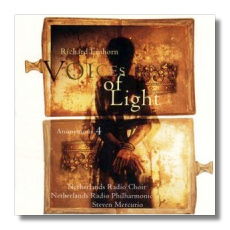
The Internet's Premier Classical Music Source
Related Links
- Latest Reviews
- More Reviews
-
By Composer
-
Collections
DVD & Blu-ray
Books
Concert Reviews
Articles/Interviews
Software
Audio
Search Amazon
Recommended Links
Site News
 CD Review
CD Review
Richard Einhorn

Voices of Light
An Oratorio inspired by the film
The Passion of Joan of Arc
Anonymous 4, as the voice of Joan
Susan Narucki, soprano
Corrie Pronk, alto
Frank Hameleers, tenor
Henk van Heijnsbergen, baritone
Ronald Hoogeveen, violin
Naomi Hirschfeld, Michael Feves & Harm Bakker, gambas
Netherlands Radio Choir & Philharmonic Orchestra/Steven Mercurio
Sony SK62006 70:40
This sensational work has had over 100 performances to international acclaim since the mid-1990s. It is a setting of a selection of words by medieval mystics, and some by Joan of Arc, for a range of musical forces ranging from solos for voice, gamba, and violin – and bells – to full mixed chorus with orchestral accompaniment (mostly high and low strings.) Quiet as much of it is, its beauty, its rhythmic excitement, and its forward motion (notwithstanding some repetition) have kept me leaning into this music through several hearings now. As a modern setting of medieval texts it is the antithesis of Orff's Carmina Burana, certainly as regards the meaning of the words, which can be ignored easily, if the listener prefers, as they are in medieval French and Latin, though if you do read them you can see that the changes in the music is well expressive of their varied sense. As for the varied sounds of the music itself, these range from the utmost stillness, in a chant style, to driving rhythms, some of which are in fact reminiscent of – yes, Orff at times, and perhaps Glass. The chorus can be very full-throated also. There are a fair number of silent moments in the music and the gamba solos contrast with give relief from the vocal passages, which can be intense. Some passages sound Andean.
It surprised me to learn that Einhorn, an American, studied at Columbia with Ussachevsky and Davidovsky, pioneers of electronic music forty years ago. (I have to admit I don't know what they have done since.) To be sure, Einhorn uses a synthesizer in his composing process, but I certainly would not have known that from the performance here. (Among composers of the past, Einhorn's tastes range from Perotin, to Bach, to Bartók and Stravinsky, among those he mentions.) It was also surprising to learn that although Einhorn worked as a producer of recordings, he was reluctant to promote his own work, to the extent of turning down an initial request from the office of Peter Gelb at Sony for a tape of a performance. Fortunately for many listeners he was persuaded to relent. For me, this has instantly become a cherished recording, and I strongly doubt that that will change.
Copyright © 2003, R. James Tobin


















